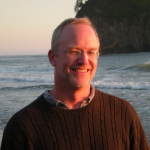Water Circulation & Exchange Within the Lake
Major Haw River flow events have a significant impact on much of the lake, but “normal” lake circulation is complex and frequently bi-directional.
Key Questions
- What is the circulation in the lake?
- How do water quality parameters vary in time and space in the lake?
- Does the Haw River impact water quality in the upper lake?
Research Findings
- Major Haw River discharge events have significant impact on much of the lake.
- “Normal” lake circulation is complex.
- We are just beginning to get a quantitative understanding of what defines “normal” lake circulation.
 Rick Luettich | UNC-Chapel Hill
Rick Luettich | UNC-Chapel Hill
Rick Luettich has an undergraduate and master’s degree in civil engineering from Georgia Tech and a doctor of science in civil engineering from MIT. He serves as the Director of UNC’s Institute of Marine Science, which is comprised of approximately 75 residential faculty, staff and students located on the coast in Morehead City, North Carolina. He also serves as the Director of the UNC Center for Natural Hazards Resilience and is the lead-PI on the Department of Homeland Security Coastal Resilience Center of Excellence and on the recently completed US IOOS Coastal and Ocean Modeling Testbed.
He has published over 100 scientific papers and reports on modeling and observational studies of physical processes in coastal systems. His modeling has emphasized the development and application of unstructured grid methods that are optimized for geometrically complex systems such as sounds, estuaries and tidal inlets and high performance computing systems. He is one of the principal developers of the ADCIRC coastal circulation and storm surge model and has overseen applications ranging from interdisciplinary studies of physically mediated migration, larval dispersal and water quality, to coastal hazard delineation to hindcasts and forecasts of tides and storm surge/inundation along the US coast.
 Harvey Seim | UNC-Chapel Hill
Harvey Seim | UNC-Chapel Hill
Dr. Seim’s research focuses on understanding the processes that control the circulation and water mass structure of estuaries, the coastal ocean and lakes and the meteorology over the coastal ocean. The principal tools used in his research are observational studies. His general areas of interest include ocean observing systems, turbulence and mixing processes, internal hydraulics, estuarine subtidal and tidal dynamics, shelf dynamics, high-frequency acoustics, boundary-layer meteorology, marine spatial planning.
